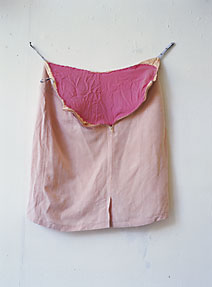|
Andreas Exner Red
trousers and a yellow skirt hang on a wall. The openings at the waistline,
which surrounded a female body, are covered with colorful fabric that
matches the color of the clothing. The material on the wall is reminiscent
of a painter’s canvas and the projecting threads are like drops of
paint. In the 1960s, painters like Frank Stella tried to burst picture
frames asunder by letting aspects of the painting extend into the surrounding
space. This was also a reaction to gestural painting, which asserted the
autonomy of the world of pictures and which claimed to create a world
of art within the picture frame that was totally independent from the
reality of the living world. The picture «that doesn’t fit
in the picture» became an object in the space occupied by the everyday
world of the spectator. This has been a subject of discussion since the
1920’s, when El Lissitzky—who considered architecture to be
the highest form of art—challenged artists to turn away from painting
tableaux and enter real space. Lucio Fontana, for example, slit canvases
open and brought the dark depths of real space into the surface of his
paintings (1958). Conversely, Charlotte Posenenske bent the painter’s
cardboard (1966). On the one hand, Exner’s clothing refers to a certain
tradition of painting—which is why they hanging on the wall. On the
other hand, they are «soft sculptures». Whereas Claes Oldenburg
enlarged hard objects (typewriters, light switches, etc.) to soft and
grotesque sculptures, Exner restricts himself to the inconspicuous manipulation
of fabric as a soft material . The gentle act of sealing the open waistline
does not permit the thought that the work is about clothing to vanish
completely. The relationship to everyday life remains; this skirt-like
work of art makes one imagine a woman, especially because the «skirt»
is a used skirt, which must have belonged to a particular woman. The folds
in the cloth remind us of a body and its movements; but in a way completely
different from Christian Boltanski, who thematically turned used clothing
into gloomy representatives of the dead. With Exner’s work, one thinks
of life; a thought which is enhanced by bright colors. His work is two-fold-on
the one hand it is painting and on the other hand it is sculpture. It
obviously refers to practicality and its role in understanding art. Andreas
Exner was born in 1962. He usually works with fabric, which either flows
down a wall like a curtain or hangs from a ceiling and he fulfills an
age-old pretension of painting: paint is not brushed on, but materialized,
substantiated, rendered independent. It is the paint itself which makes
the sculpture. Burkhard Brunn
|
